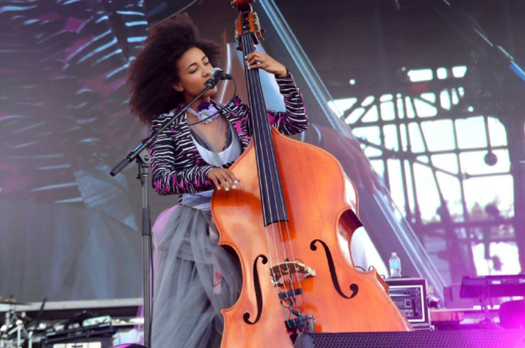The jazz club, with its dim lighting and closely packed tables, looms large in our collective imagination. But today, the music is thriving in a host of different spaces.
ImageThe vocalist, flutist and producer Melanie Charles sings at a rehearsal in her Brooklyn home, which has become a rehearsal space, recording studio and gathering spot.
The vocalist, flutist and producer Melanie Charles sings at a rehearsal in her Brooklyn home, which has become a rehearsal space, recording studio and gathering spot.
A disco ball threw beads of light across a crowded dance floor on a recent Monday night in Lower Manhattan while old film footage rolled across a wall by the stage. A half-dozen musicians were up there, churning waves of rhythm that reshaped over time: A transition might start with a double-tap of chords, reggae-style, from the keyboardist Ray Angry, or with a new vocal line, improvised and looped by the singer Kamilah.
A classically trained pianist who’s logged time with D’Angelo and the Roots, Angry doesn’t “call tunes,” in the jazzman’s parlance. As usual, his group was cooking up grooves from scratch, treating the audience as a participant. Together they filled the narrow, two-story club with rhythm and body heat till well past midnight.
Since before the coronavirus pandemic, Angry has led his Producer Mondays jam sessions every week (Covid restrictions permitting) at Nublu, an Alphabet City venue that feels more like a small European discothèque than a New York jazz club. With a diverse clientele and a varied slate of shows, Nublu’s management keeps one foot in the jazz world while booking electronic music and rock, too. On Mondays, it all comes together.
As New York nightlife has bubbled back up over the past few months, it’s been a major comfort to return to the legacy jazz rooms, like the Village Vanguard or the Blue Note, most of which survived the pandemic. But the real blood-pumping moments — the shows where you can sense that other musicians are in the room listening for new tricks, and it feels like the script is still being written onstage — have been happening most often in venues that don’t look like typical jazz clubs. They’re spaces where jazz bleeds outward, and converses with a less regimented audience.
“The scene has started to fracture,” the drummer and producer Kassa Overall, 39, said in a recent interview, admitting that he didn’t know exactly what venue would become ground zero for the next generation of innovators. “I don’t think it’s really found a home yet. And that’s good, actually.”
It’s an uncommonly exciting time for live jazz. Young bandleaders have wide followings again — Makaya McCraven, Esperanza Spalding, Robert Glasper and Christian Scott aTunde Adjuah each rack up millions of plays on streaming services — and a generation of musicians and listeners is lined up to follow their lead, or break away. This year, for the first time, the most-nominated artist at the Grammys is a jazz musician who crossed over: Jon Batiste.
These players’ music has never really seemed at home in jazz clubs, nor has the more avant-garde and spiritual-leaning work of artists like James Brandon Lewis, Shabaka Hutchings, Angel Bat Dawid, Kamasi Washington, Nicole Mitchell or the Sun Ra Arkestra, all of whom are in high demand these days.
Maybe it’s a case of coincidental timing. A confluence of forces — the pandemic, the volatility of New York real estate, an increasingly digital culture — has upset the landscape, and with the music mutating fast, it also seems to be finding new homes.
Jazz is a music of live embodiment. Part of its power has always been to change the way that we assemble (jazz clubs were some of the first truly integrated social spaces in northern cities), and performers have always responded to the environment where they’re being heard. So updating our sense of where this music happens might be fundamental to re-establishing jazz’s place in culture, especially at a moment when the culture seems ready for a new wave of jazz.








More Stories
Interview with Janis Siegel of The Manhattan Transfer: Jazz, being a more refined, interpreted form of music
CD review: George Benson – Dreams Do Come True: When George Benson Meets Robert Farnon – 2024: Video, CD cover
The band was tight as ever. The Warren Haynes Band cuts loose: Video, Photos